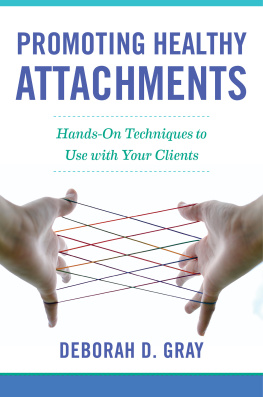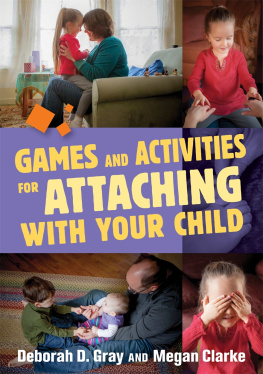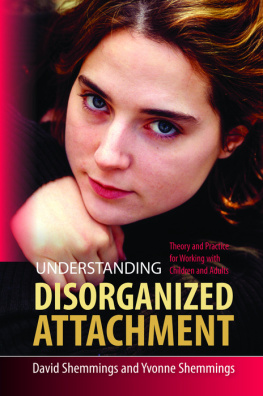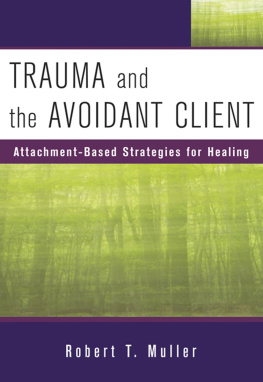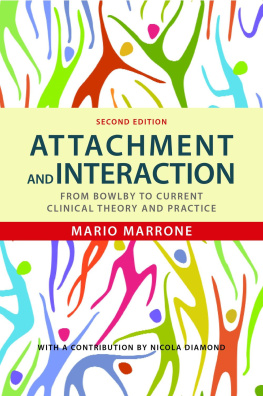
Promoting Healthy
Attachments
Hands-On Techniques to Use
With Your Clients

Deborah D. Gray

W. W. Norton & Company
Independent Publishers Since 1923
New York London
A NORTON PROFESSIONAL BOOK
To my sister, Colleen, who sings the high descant
in my lifes song
A therapist told me, I know attachment theory. But my dilemma was, what to do with parents and children who come into my officebesides talking about attachment. How do I spend the therapy hour? In your training, I came away with things to do that I used the next day. In the spirit of knowing what to do during therapy hours, I am contributing this practical guide.
Attachment literature is rich. Other authors have covered attachment theory and its history so skillfully that I would not attempt to repeat their successes. This book emphasizes day-to-day processes as therapists coconstruct and carry out treatment plans with their clients, improving the quality of attachments. I include theoretical and research contexts to provide a foundation for techniques and approaches.
While the book is practical, I see therapists as more than mental health mechanics. This book is not a set of instructions. Instead, we clinicians use our skills much as musicians use theirs. Our music, created with our clients, includes connecting, making sense of life events, and engaging empathically as clients struggle toward integration and regulation. Our skills include graceful phrasing, timing, direction, knowledge application, and technique. (We also may have lousy timing and messy redoshopefully, with repair.) Beyond the left-brain cognitive skills described in this book, I cheer the use of therapists right-brain-mediated music as we make connections with our clients and help them to connect with each other.
I have practiced as a therapist at a favorable time. At the beginning of my career, John Bowlby, Mary Ainsworth, and Vera Fahlberg helped me to see patterns of attachment behavior, especially after maltreatment. I remember the excitement of using attachment techniques in a neonatal nursery, and in making connections between parents and their foster children. The parents were thrilled when their children responded. Throughout the 1990s and into this century I was influenced by the work of Mary Main, Mary Dozier, Diane Fosha, Eric Hesse, Daniel Hughes, Michael and Marjorie Rutter, Bruce Perry, Allan Schore, Judith Solomon, Marion Solomon, Daniel Stern, Allen Sroufe, Daniel Siegel, Bessel van der Kolk, and Charles Zeanah. Of course, there are other wonderful authors and theorists not mentioned in this list. These individuals helped me to appreciate the ways that therapists could effect changes in the complex system of parent-child attachments. They helped me to arrange trauma, neglect, loss, and attachment theory into a working model for treatment. Many of the authors in the list above continue to shape our field and my work.
As Allan Schore (2002, 2012) aptly teaches, so much of our therapeutic work is led by our intuitive right brain. This intuitive dimension allows therapists to think well beyond the confines of cognitive-behavioral therapy or other technique-driven skill sets. This book emphasizes that effective therapy with our clients requires a compassionate therapist who also has therapeutic skills. I hope that readers will feel a new appreciation for the dynamic nature of therapy as they express creativity and wisdom with their clients.
Children and families in my practice are my richest sources of information. I have learned from parents as they describe and demonstrate what seems to work best for their children, especially after maltreatment or attachment losses. I have had the opportunity to collect their successful techniques and approaches, passing them on to other families, other therapists. While I have changed identifying information to protect confidentiality of clients, you will hear my clients voices in the scripts and examples in this book.
The book is organized in parts. In , I summarize some attachment-oriented research projects and ways in which all practitioners can benefit from their lessons
, I discuss plans and practical activities that have worked for my clients and me.
and beyond, I share many physical techniqueswith respectful boundaries, of course.
focuses on childrens attachment issues, primarily children with complex trauma or traumatic grief. The chapter provides many practical ways to help families who are attaching to children who have difficulties with trust, regulation, theory of mind, reciprocity, and anger. I have included information on children adopted internationally or through the foster care system.
concentrates on treatment of adults with attachment issues. The chapter discusses therapist countertransference issues with their clients. When dealing with parenting and childrens needs, countertransference issues are particularly vivid. This chapter describes child-parent dyadic work when parents are presenting with insecure attachment patterns.
I incorporated a specific chapter on adolescents. links the joint tasks of increasing autonomy while improving security in attachment. We look at some practical methods of helping families enjoy the adolescent process of roots and wings. The development of smart technology makes connecting with teens an intentional and sometimes competitive process, as described in this chapter.
therapy for these families. Multiple studies point to differences in executive functioning in children after neglect and maltreatment and in parents after chronic high stress (Fisher, Van Ryzin, & Gunnar, 2011; Nikulina, Widom, & Spatz, 2013). This chapter discusses the pragmatics of working with people whose brains were shaped by high levels of stress.
discusses spirituality and faith. Many people reach out to God as their spiritual attachment figure. I describe working with clients who include their faith in a holistic, attachment-informed, worldview. This brief chapter is meant to provide integration between the spiritual and temporal for people who view God through an attachment lens.
concludes the book with a discussion on play and attachment. We achieve a light-hearted, but fully alive feeling when playing. It is often an unwrapped gift in attachment relationships. I finish the book with an invitation to enjoy the gift.
This book is a positive one. In spite of my daily work with neglect and trauma, where I am often a witness to suffering, I am compelled by people who create hope and camaraderie, mustering resources to overcome adversity. On a practice level, it is exciting to integrate sensorimotor attachment techniques and to apply the attachment, regulation, and trauma literaturesall while joining with families in a kind manner. The work brings out the truest parts of myself, even as I see and encourage the best in my clients.
A ttachments are our closest relationships. From infancy, when our socialemotional brains are wired within attachment relationships, throughout adulthood, when we care for and coregulate others, our attachments provide our physiological and emotional roots (Schore, 2003a; Siegel, 1999; Sroufe, 1995). We crave attachments with others, hoping that these people will be caring, resourcefuland long lived. As children, we are the recipients of care from attachment figures. As parents, we are the attachment figures, providing for children. As adults within adult attachment relationships, we engage in mutual caregiving. People learn the responses of caregiving and mutuality through their childhood attachments, replaying the reciprocal role as adults.
Next page
